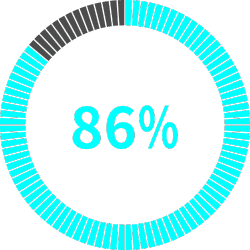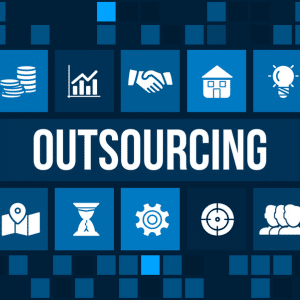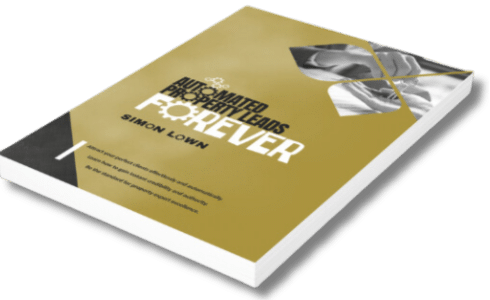It cannot be stated strongly enough that creating a content goldmine for your business will be of such immense value that you’d be crazy not to get started. Naturally, there’s always more to it, and to automate your lead generation (AKA your content goldmine) is up there in importance, right after you start creating it.
If you want to automate your lead generation and let’s be honest, who wouldn’t? Then this post will give you an overview of what you need to do.
If you’re stuck chasing down every low-quality lead manually, then your content goldmine combined with these simple automations will change the way you look at the property industry.
Why Content is King in the Property World
It is well understood that the property industry is a people business. Relationships are amongst the most critical aspects of successfully building a property-based business.
So, how do you build a relationship when over 70% of people don’t even want to speak with you until after they’ve looked you up online?
Building Trust with High-Quality Information
If you want to succeed in the 21st century without spending tens or hundreds of thousands on ads and brand-building campaigns, you really only have a few options.

One of the most successful, and also one of the lowest-cost methods available today, is creating high-quality, well-researched, easy-to-consume content. For simplicity, I like to call it expert content. Create enough expert content, and you have yourself a content goldmine.
Why a content goldmine?
Well, quite simply because your content delivers enormous value to your perfect prospects and clients. It’s a valuable resource that allows you to generate highly qualified leads. Being a valuable source of information, it gives you credibility and builds rapport.
Quite frankly, that could end up being more valuable than gold.
So, this all sounds great; what’s missing?
Driving Traffic: The Fuel for Your Digital Property Empire
Traffic to your website is the missing piece of the puzzle. The fuel to turn your content into gold is people finding and consuming your content.
This is where things start to go downhill for most businesses.
As of January 2023, there were around 5.5 million businesses in the UK, and an estimated 83.4% of them have a website.
Okay, so around 4,587,000 businesses have websites in the UK, and I am assuming that all of them want to be found and for people to get their product or service. So, how do you find what you need, especially since when you go looking, you’ll find a website not just from the UK but all around the world?
Luckily, there is a solution.
There’s this company you might have heard of called Google, who are there to help.
The trouble is, EVERYONE wants to be at the top of Google search. This means that if you want traffic from the best “free” traffic source in the world, you’ll have to help them out.

Why “free” traffic?
Well, creating expert content for your goldmine costs both time and money. The main difference between your investment in content and a paid advertisement is that an ad works once per view/click/conversion; your content, on the other hand, will deliver hundreds, if not thousands, of results when done well. You put the time and effort into your expert content once, add a sprinkling of paid services to optimise it, and it can deliver over and over for years to come.
Conversions: How Content Leads to Bookings and Inquiries
One of the biggest problems that property professionals face is that when somebody first thinks about buying/selling/investing/building a property, it can be months, sometimes years, before they are ready or able to move forward.
If you’re ‘hoping’ and ‘wishing’ that people choose to speak to you when you’re not doing everything you can to ensure they find you when they first start looking for answers, you’re losing out on at least 76% of the potential business that could have come your way.
Yes, in a study conducted by Visual Objects, 76% of consumers said they would not speak to a business before researching them online. You’re mistaken if you think that not as many people in the UK are as internet-dependent as our American cousins.

A 2021 Ofcom study found that 86% of UK consumers don’t purchase without researching a product or service online. 88% of consumers in a 2022 BrightLocal study found that online reviews were trusted as much as a personal recommendation.
So, if you want to be in the running, you must have an online presence. The best way to do this is to start with your content goldmine and then use SEO to make sure that people find you. SEO allows Google to help you by ensuring they understand everything they need to know about your website, content, and intentions. It really is as simple as that.
Relying upon word-of-mouth referrals is getting just as hard as online selling since the number of property professionals getting in on the review bandwagon is steadily rising. And, you know that if you’re one of the dozens of other companies all looking like cookie-cutter versions of the same info, the one that does the best job of standing out and being different will win.
More Bookings, More Inquiries, What Has Content Got to Do with It?
Let’s say, for example, you’re an estate agent in Luton, Bedfordshire. When I last worked in that environment in 2019, there were around 63 agents. Suppose you’re a Luton resident and decide you want to sell your home.

You’ll be aware of a few agents from your route to work. Maybe you remember a few from the last few times you were in town.
You may even know an agent through a friend or a relative.
What if, when you go online and start Googling the questions people ask when they think about selling a home, that one agent keeps popping up with precisely what you need?
It doesn’t seem to matter what you Google:
- What is the current market value of my home?
- How long will it take to sell my home?
- What are the best ways to market my home?
- How much should I spend on staging my home?
- What are the closing costs?
- What are the legal requirements for selling a home in Luton?
- How do I find a good estate agent?
- What are the costs of selling a home in Luton?
- Are there tax implications when selling my home?
- What are the risks of selling my home?
Every time, the same agent pops up with an answer that gives me all the details and tells me things I wasn’t aware I should be asking. They even tell me how scams work, dirty tricks that desperate agents might use and what to look out for when choosing an agent to work with.
And the bonuses…
Not only that, but they also have checklists, cheat sheets, and simple quizzes to help me understand my needs better, all ready to download for free. I just give my name and email, and I have it in a few seconds.
Then, I get emails with even more videos, testimonials, related content, and other helpful information that makes me feel like I know exactly what I need to do when I need to do it, and what I can expect throughout the process and these amazing people aren’t even trying to sell me anything or hassle me with phone calls trying to get me “onboard”. Not to mention that these guys seem to pop up everywhere I go around the web.
When it comes time to put my home on the market, who will I contact first?
Now you understand the power of a content goldmine.

The Daunting Task of Manual Content Creation
It shouldn’t come as a surprise that creating expert content isn’t as easy as just sitting down at your computer for an hour and just typing away until you’re happy you’ve finished writing your latest post.
If you’ve never written expert content before with the expectation that I might rank well on Google, then you won’t be surprised to know that you’re not alone. You also have a little catching up to do.
Fortunately, the process is reasonably straightforward. If you’d like to get the complete process of creating a content goldmine for your business, I’ve put everything you need to know in my latest book, Automated Property Leads Forever. You can grab a copy for as little as £6.95 and start today.
I thought I’d get that out there early on since this is a very long post. Now you won’t be wondering how on earth you’re going to figure all this out by yourself. You don’t need to. We’ll cover more on that next.
The Time Drain: Why Doing it All Yourself Isn’t Sustainable
If you want to create a fully-fledged, in-depth content goldmine that attracts your perfect prospects on autopilot, I humbly suggest that doing it all by yourself is a mistake.
Talk to your team, if you have one and discuss your plan for local domination with a content goldmine and see which parts might interest each person.
There is nothing wrong with outsourcing various elements of your content goldmine. It will help you stay consistent and give you a level of accountability that will ensure you stay on track.
Parts of Your Content Goldmine You Could Outsource
While you can outsource many aspects of a content goldmine, the one part I would say cannot be handed off to a third party is the content itself.
You can get other in-house experts to write content, but you shouldn’t get a ghostwriter or any other type of generic content created for you. It completely defeats the purpose of a content goldmine. That is, to make a digital representation of you. Nobody else can speak in your style or convey your stories, experiences or passion.
So, let’s take a look at some of the other areas you can get some help with.

Competitor Analysis
If you have spent some time working on your content creation list, you could start the outlining process for your content, then hand it off to a third party to complete the competitor research, suggest keywords, and report on the chances of your content ranking on page #1 of Google.
This could also include reporting on the competitor’s authority, consistency, output volume and various other areas.
Content Review
If you have completed your mission statement with a full list of your values, what you stand for and what you stand against, you could get an editor to help you review and refine your content.
Retargeting Your Prospects
Digital Marketing Agencies and freelancers can help with the technical aspects of setting up your retargeting. They can also help with A/B testing your ads and possibly could help with your nurturing sequences. Remember that the more you want them to assist, the higher the monthly subscription will be.
Website Audits and Reviews

Checking and fixing technical aspects of your website for SEO-related issues can easily be outsourced. Just be sure that they have experience with the technology your website is hosted on. Wix, Squarespace, and WordPress all have different skill sets. While SEO requirements between hosts don’t change, how you apply them can.
Your Perfect Prospects
While I would expect most agents to be able to figure out a client persona for their perfect prospects, help is available from market research companies to develop customer personas.
Content Posting
Once you’ve written a post, you will then post it on your website. Seems obvious, but there’s more. This means you’ll need a cover feature photo for the post and, depending on the length, several images placed throughout the content. This all takes valuable additional time.
Video Editing
Some powerful tools are available completely free for creating and editing videos. This can be time-consuming. It’s not just the editing process but the learning curve if it’s not already in your skillset. This might be a big time saver when it comes to outsourcing elements of your content goldmine.
Validating Your Content Goldmine
Fact-checking your content is extremely important. If you don’t have a team to check each other’s work, this could be a helpful area to outsource.
Social Media Management
Creating new images, posting regularly across multiple platforms, and repurposing existing content takes time and needs doing every day. And let’s not forget to engage with your audience. While it would be good if you could reply to each and every one of your followers personally, realistically, when you grow beyond several thousand followers, you’ll likely need some help.
As you can see, there are several areas that, while necessary, will potentially take a back seat to actually doing the work that will keep your clients happy. Creating a content goldmine could quickly become a full-time job if you let it.
While some areas will get easier, quicker, and more efficient over time, it might be a little overwhelming

initially. If you’re trying to learn multiple new skills simultaneously, you’re unlikely to excel at them for some time, let alone all of them.
If you want to outsource multiple areas of creating your content goldmine, taking on a few virtual assistants via an agency might be more manageable. Whatever you decide to do, you need to think about all aspects of creating your content early on so that you don’t get overwhelmed and end up stopping because you don’t have time.
The Costs of Human Error: Typos, Inconsistencies, and Lapses in Updating
If you choose to hire an editor to review your content as one of your outsourcing activities, then you’ll need to worry less about typos and inconsistencies.
If not, then you should use one of the many grammar checkers available to assist with your writing. I use a premium subscription to Grammarly, which helps me keep my writing consistent.
I can think of few things that scream amateur more than spelling mistakes, incorrect grammar, and poor punctuation. It’s just not necessary. If that’s not all, it will destroy your efforts and the entire reason you’re creating a content goldmine in the first place. Yup, you’ve guessed it: time for more facts from studies.
- According to a study by the University of California, people are less likely to trust information that contains spelling mistakes.
- The Texas University at Austin found people will find a website less credible when spelling mistakes are present.
- Fewer people will finish reading a document if poor grammar is present, according to a study by Waterloo University.
The point of creating a content goldmine is to:
- Position you as an expert
- Be a go-to source of valuable information
- Increase your credibility
- Persuade people that you are a safe bet amongst a sea of sameness
- Make you more memorable (for the right reasons)
By having poor grammar, incorrect spelling, and missing or incorrect punctuation, you undermine everything you’re trying to achieve. You need to ensure that does not happen.
The Need for Speed: Market Trends Wait for No One

When you outsource elements of your content goldmine creation, you will also find that your experts will advise you on new trends, tips, tricks and tactics that speed up your journey to being the best-known, most trusted agent in your area.
Without that outside help, you’ll always be a lot further behind the curve than is healthy in a highly competitive business such as the UK property market.
The faster you can get on board with the latest trends, the more you will benefit from them.
Automation to the Rescue: An Overview
To automate your content goldmine, you don’t need much.
With your automation, you are trying to achieve increased brand awareness, high levels of value, and consistent engagement with your target audience.
What Does Automating Your Content Goldmine Mean?
The main focus of your automation is collecting names and email addresses. This will mainly be to populate your autoresponder email lists since if, for example, you are using a chatbot for Facebook Messenger, you only need responses since you can automate collecting and collating messenger contacts on the back end.
Everything happens with the follow-up. Once somebody visits your website, you can retarget them with Facebook retargeting ads for up to six months.

Setting up a sequence that can ensure you keep getting your visitors back until they take an action that enables you to follow up with emails, texts, WhatsApps, or messengers is all you’re trying to achieve initially.
Once you have that, you can over-deliver with vast amounts of value until they are ready to reach out to a business and discuss their required services.
The Benefits You Can’t Ignore: Efficiency, Accuracy, and Timeliness
One of the best parts about automating your follow-up and nurturing is that it does it no matter your mood. Feeling off, your level of health or wellness, or how forgetful you might be play no part.
It does what you’ve told it to do daily, without fail, until the prospect is ready to become a client.
The Spectrum of Automation: From Semi-Automated to Fully Automated Systems
Levels of automation can be simplified into things you have to monitor and manage all the way through to set and forget.
Anywhere you outsource a component of your content goldmine, you can consider that an automatic part of your system. Assuming all is well with your 3rd party, they know what is expected of them, and you’re providing anything they require to do their part, then all should be well.
In terms of the set-and-forget elements, there aren’t many. Apart from always wanting to monitor and improve your systems, updating your systems with new content, follow-up series, content upgrades, and the like will always need attending.
However, once you have an autoresponder setup for a specific lead magnet and a follow-up sequence has been created, the essential and automatic part of collecting a name and email, then delivering the valuable content upgrade and nurture sequence, is truly hands-free.
The same goes for chatbot sequences and follow-ups.

Even collating all of your contact details from various sources into a CRM and adding updates to the stage each lead is at in the content funnel can all be automated. If you set up your CRM well, it can generate reports, generate notifications, track your sales pipeline and automate your workflows.
What’s important is that you’ve collected a way to follow up with your leads. Trust and rapport are built through continuous follow-up with expert content and retargeting around the web.
Ultimately, this will lead you to the opportunity to speak with your perfect prospects. Everything after that is down to you. Your content can position you as an expert and get your leads to know, like and trust you. The conversion from hot prospect to client will be in your court.
Must-Have Tools for Content Automation
While you can get started with just a few basics, the longer you leave moving over to scalable tools that can grow with your business, the more challenging and more of an upheaval it will be when you migrate your data and systems.
Content Management Systems: The Backbone of Your Content Operation
A content management system (CMS) is where your content will live. Depending on your type of business, there are many options available.
One of the most popular and powerful CMSs is WordPress. But it is far from the only CMS available.

You could consider Drupal and Joomla, both open-source, free CMSs that offer a lot of flexibility and advanced features, much like WordPress.
Hubspot is another popular system that offers marketing automation, CRM, and analytics.
Other available systems include Wix, Squarespace and Weebly. These are more basic CRMs and will likely need to be upgraded when you grow significantly. They’re great for non-techy beginners but lack the power and advanced features of other CRMs.
Social Media Schedulers: Reaching Your Audience Even While You Sleep
Schedulers for all social platforms have become extremely popular over recent years, and it’s not hard to see why. The algorithms on many of these platforms require a consistency that is difficult, if not impossible, to manage for busy people.
If you can get a VA or an in-house staff member to post across multiple platforms, live and organically, there is emerging evidence that this increases your reach. It seems that social media favours real people posting over an automated system. Will wonders never cease? 😊
That said, if a VA or dedicated staff member is beyond your current budget, using one of the following tools is still perfectly acceptable.
In no particular order, they are:
Which tool will be best for you will depend on your needs. There are various free plans and full trials you can use to test which will be the most suitable for your business. While it’s possible you won’t find what you need on this list, there are always new tools being developed and released, especially in the new AI age we’re entering. Keep your eyes open for the latest and greatest tool that everyone is using.
Automated Analytics: Data-Driven Insights at Your Fingertips
We’ve already talked about ensuring that you have access to data about your website visitors, and Google Analytics is one of the best options. Although most people getting started won’t need anything more initially, it is worth noting that is not the only option available.

More advanced analytics platforms aim to make your data easy to read at a glance, highlight trends, identify potential issues, and produce reports such as forecasts and historical data, and integrated AI will likely become standard.
Google Data Studio is a good place to start as a Google Analytics user.
Other options include:
Which will be suitable for your business will be determined by what you need from the tools, your data sources, and your budget.
AI-Powered Writing Assistants: When You Need That Extra Creative Spark
I’ve already mentioned that I use Grammarly Premium, which makes many excellent suggestions. It should be noted that not all the tips it makes are good. Having access to alternative words instead of using the same word several times throughout a paragraph can make my writing more interesting and engaging.
However, many suggestions will change the tone or the essence of what I want to say. While Grammarly is very good at making a sentence more concise, sometimes, I want to emphasise a point and don’t want to use the fewest words possible. I will also try to use specific word structures or frameworks that I feel just do not work in certain situations. For example, in the last sentence, Grammarly wants to remove “I feel just” since it isn’t “necessary”. Grammarly doesn’t like filler words such as “that”, “just”, and “so” and will often try to remove them. I will keep them in occasionally because it feels more natural and keeps my writing from being too clinical.
That said, I don’t think I’d like to publish anything without running it by Grammarly first. Not yet, anyway.
Unless you’re excellent at spotting typos and grammar errors and are confident in your word choices to the extent that you never get them wrong, I suggest you use a writing assistant.
Here are a few to check out:
Many tools popping up off the back of the “AI Revolution” are geared towards writing for you. I suggest avoiding these since you don’t want your content to be generic and dull. Avoid the temptation and use a writing assistant to ensure you stay true to yourself.
Crafting Your Content Pipeline
Your content pipeline is a process you can systematise to ensure you deliver your expertise consistently to your leads, prospects and clients.
You never want to find yourself in a situation where you’re not sure what you will write about next. The idea of sitting in front of your computer, staring at a blank screen, and waiting for inspiration to strike is a complete load of rubbish.
And yes, I did have to temper the end of the last sentence. 😉

Creating expert content has little to do with inspiration and everything to do with planning what you’ll create and making the time to get it done.
Let’s dive into how you’ll breathe life into your expertly created content goldmine.
The Life Cycle of Automated Content: From Idea to Publication
The process of creating expert content is easy to learn. It will become second nature once you’ve done it a few times. Why wait?
Conceptualising Ideas
While I get you started with some easy wins in my book, Automated Property Leads Forever, by getting you to use the most asked questions as inspiration for your content, you will eventually cover them all.
Ideas can come to you any time of day or night, sometimes at the most inconvenient time. Whether that’s in the shower, during an important meeting, or driving through rush hour traffic whilst late for a viewing.
What is important is that you try to capture the idea at the earliest opportunity. Not every idea will turn into a piece of content gold; many might be discarded or altered beyond all recognition once you start to work your thoughts into your content plan.
That’s fine. It’s all part of the process. Not every idea will make good content. Some will be amazing though, and could come out of the blue.
Brainstorming Techniques
You may prefer to brainstorm your content ideas as well as just trying to capture your daily inspirations.
There are various methods you can use. Here are a few to try:
You can use some or all of the methods listed. The best way for you will depend on the number of people involved and your dynamic in the workplace.
Rules for Brainstorming
It’s fair to say that no idea is bad in a brainstorming session. When you start to sort and add your content ideas to your plan, you can begin to discard ideas that don’t fit in with your brand ideals, services, and values.
Depending on your work environment, setting a few ground rules for every session might be helpful.
They might look something like this:
- Set the tone (explain the purpose of the session)
- Encourage wild ideas (The more outlandish, the better)
- No criticism is allowed (especially by owners/senior management)
- Build on each other’s ideas (Use the ‘Yes, and…’ improvisational technique)
- It’s okay to disagree (Has to be respectful and focus on the idea, not the person)
- Take breaks (Maybe set a series of pomodoros)
Of course, you should come up with your own rules. Just ensure they allow everyone to contribute without fear of ridicule, reprisals, or ongoing judgments. The objective is to create a safe, open space where creativity and innovation can thrive. By setting the right atmosphere and guidelines, you can foster a collaborative environment that generates numerous ideas and strengthens team cohesion and morale.
Tools for idea management
It’s fair to say that you should keep your ideas safe for when you can start turning them into your next viral piece of expert content.
So, how will you achieve this?
Well, there are several ways you can store your ideas and various tools to help you.
Here are a few you could use:
There is no correct answer for how you store your ideas or the process you choose to turn them into your next post.
Personally, I use multiple ways to store ideas.
Building a Second Brain
The last item on that list might deserve more of an explanation. I listened to an audiobook by Tiago Forte called Building a Second Brain. As a result, I use Microsoft Onenote to capture anything I need to on my phone, most often, and then, on occasion, I’ll sort everything into various categories using my desktop PC. Instead of explaining the concept of building a second brain here, I suggest you get a copy for yourself.
Another method I used when I wrote my book, Automated Property Leads Forever, was to plan it out using Trello. Fortunately, I already had a lot of content available because the book is based on my Property Leads Accelerator coaching programme. Trello was an easy way to organise what I wanted to write and move things around between various categories until it all looked right.
I also use Google Docs to store things from other people since many people use it these days. My Microsoft Onedrive syncs with my desktop PC, phone, and tablet. Everything I write, including my book and this post, is stored in my Onedrive before posting or publishing.
When planning my coaching programme, I used Mind Mapping to design the various elements of what I would teach. I still have access to everything I’ve noted, created, designed, and planned over the past several years. I’m probably a little overdue for a clearout, but while I have plenty of room to store everything, there’s no urgency. Yet! 😊
As long as it works for you
Whatever system you choose, know that you’re not stuck with it, no matter what. Like me, you might decide to use more than one system. As long as you can give the right people access at the right time, it’s all good. Different methods will work better for various tasks and projects. Don’t be afraid to try something new. You might just find the next best thing since sliced bread.
Personally, I’m always open to a new of working. I can always bin it if it doesn’t deliver.
Content Research

Researching is essential for expert-level content creation. Even if you are the most knowledgeable person on the planet about the topic you’re writing, you might not get anybody reading it if you don’t understand how to relate to your audience.
Once you have a topic you’re going to write about and have outlined the main sub-sections you want to cover, it’s time to go and see what your competitors have come up with.
The easiest way to do that is to Google it.
Sources for Effective Research
Depending on what you’re writing about, Google will likely be one of the best sources you can use for research purposes. Now, if you’re covering legal issues in the UK housing market, for example, then it may be that a white paper is a better source of information or an article from a property ombudsman. If you’re in a legal-based profession, I don’t need to tell you how to look up statutes, cases, and practitioners’ handbooks, but I will remind you to cite the relevant texts correctly.
Books, blogs, and vlogs are also good sources of information, but remember to do your due diligence on the content creators.
Depending on your subject, you’ll likely know where the best sources of information are. It’s still worth checking out other sources, though.
One of my favourite new sources of information is AI. I regularly use GPT4, Bard, and Bing for various searches, depending on what I’m looking for. I’ve also recently discovered Claude.ai, which I’m quite liking.
AI does Lie
Be warned, though, I have found several facts presented by AI that turned out to be entirely made up. To be fair to the AI owners, they do tell you this when you use their AI systems. However, it’s all too easy to fall into a false sense of security. So often, AI gets its facts spot on, but when it gets the facts 100% wrong, it is presented in an entirely believable way, and there is no hint that what it says might not be completely accurate.

I’m betting that more than a few people will end up publishing a load of made-up AI fantasies as fact in the coming months and years. Sadly, I also predict that more than a few reputations will be irrevocably damaged as a result. This is why it’s so important to check everything.
Evaluating the Credibility of Sources
I don’t think there is much I can tell you about evaluating the character of a source that you won’t be able to figure out for yourself.
However, there are a few signs it’s worth being aware of.
Checking out who wrote something and whether they’re considered an expert will, of course, be the first step.
Biased content is often so because there is an ulterior motive behind it. Usually to sell you something. I don’t take any content at face value if it only tries to sell me something without delivering its own value first.
Lack of evidence is another potential warning flag. If there are no points of reference or other sources for you to validate what is being said, then you’ll need to do your own research.
It is worth spending a little time trying to figure out the purpose behind the content. Does it inform the audience? Are they trying to entertain, or are they trying to persuade you? The contents’ purpose might say something about their credibility when you understand why they created it.
Finally, and possibly most importantly, when was the information published? Too many people and businesses do not update their content. For all its fantastic technology, Google still occasionally serves up a piece of content that went out of date with the dinosaurs. It’s very unhelpful and, in some cases, quite misleading. Not every post is dated in a way that makes it easy to find.
Content Creation
If you’ve read my book, it will come as no surprise to you that I think that the expert is the one who should be creating content. As we covered earlier, many others can be involved in preparing it for mass consumption, but the core of the message needs to be pure. Just to clarify, again, even though this is a post about automating your content goldmine, you should not automate the expert content creation part of it.
When people read a post from an expert, they want to hear about their values and beliefs; they want their experience conveyed through stories and metaphors.

They want to be entertained by your bemusement at the state of other so-called experts who still do things that are considered barely legal and hear about how you helped others in their situation.
None of this will happen if you outsource your content creation.
Best practices for creating engaging content
If you want your audience to like and share your content and comment after reading, you need to make it so good that they can’t help themselves.
One of the reasons an avatar of your audience is so important is that you can only speak directly to them when you know who they are.
If you’re a good storyteller in everyday life, use those stories in your content. Everyone loves a story, and you’ll increase your chances of engaging your audience massively if you keep them hooked to find out what happened at the end.
Use strong visuals to help your audience picture your vision when conveying an idea. This also increases the chance that they finish reading your entire post and taking action once they are done.
Use humour where you can, but above all, be yourself. Once people get to know you, they’ll keep coming back to hear more because they like you. People can tell if you’re not authentic, and it’s a big turn-off.
Finally, ask questions. Even if sometimes they are rhetorical, people will still answer them in their heads. It’s as if you’re conversing with them, which you are, especially when you create your videos.
Tools that can assist in content creation
There is really no need to overcomplicate this. To create content, you only need an editor that supports formatting.
I use MS Word, but it would be just as easy if I wrote in Google Docs. The main thing is that you can use your writing assistant. I like to write blocks of text and then edit a few paragraphs at a time.
Others will prefer to finish and then edit the entire post. There is no right or wrong. What works for you is the best way to get it done.
I’ll mention one more tool here since I’ve not mentioned images yet.
Image Creation
Nearly every image I use is created in Canva using their pro photos, videos and graphics. I say nearly since I, too, like millions of others, like playing with the AI image generators.
Although I warn against using AI images commercially in my book, I was careful to use reasonably generic subjects and certainly no styles of known artists. Still, I’ve used only a couple, and I’ll limit it to that until all the reasons I list in my book are met, and AI images are “safe” to use online.
If you need images for your blogs, social media, lead magnets or any other
online part of your business, I recommend using Canva with a subscription or one of their competitors.
Using images published from anywhere other than a licenced or verified free source is a court case for copyright infringement waiting to happen.
For all of the images I use in Canva, I just don’t need to worry about the source. It’s all taken care of for me.
If, on the other hand, I grab a picture I like from Google’s image search, I have no idea what the copyright terms are for that image. Knowing that many of the largest companies providing image licensing services to creators actively search for illegal uses of their copyrighted material, I don’t think it’s worth the risk. And in case you’re wondering, no, just because the image was legally used by the company you “borrowed” the image from, it does not mean that you do.
Sure, you might get lucky and just receive a cease and desist notice, but then you could also get a bill for using an image from when it was posted to the present day.
Publication
Your main platform for publishing your expert content will be your website. While this should be your primary focus, don’t discount the possibility of guest posting on another expert’s site or writing articles for a magazine or a newspaper.
As I talk about frequently, you need to be consistent. This means creating a schedule for content creation, editing, posting, and following up on social media. This will allow your followers to make time to consume your content and will maximise your engagement.
Getting to the point where you have several posts scheduled for posting with lead magnets and follow-up sequences at the ready will help you a lot. This is all part of your automation process since life sometimes gets in the way. There will be a time when you can’t create new content, and you’ll be able to take care of family, friends, or loved ones safe in the knowledge that your business tools will continue to publish your expertise, attract your perfect prospects, and nurture them until you’re ready to get back into your usual routine.
As ever, dozens of tools will be available, but for the creation process, you only need to block out time on your calendar and ensure you stick to your schedule. It doesn’t need to get any more complicated than that.
Creating a Content Calendar: Your Roadmap to Consistent Output
Depending on the number of people involved with creating your content goldmine, it’s fair to say that only using your personal calendar to plan your content might get a bit messy and disorganised.
Here are the main points you can use to help manage your diary more effectively to consider when picking another tool to support your team.

Importance of a Content Calendar
First, and most obviously, it keeps you organised. Accountability is also built into your schedule since it makes everyone aware of the expectation of publishing at a specific date and time.
Since consistency is an important element of building trust with the search engines, creating a content calendar is a way to ensure you don’t fall behind and start missing deadlines.
Components of an Effective Content Calendar
Of course, the blog post is the most essential aspect of creating content for your website, but equally important is the video. Both need to be ready, ideally, when your blog goes live. Then, there is the social media follow-up, which needs to be created and scheduled for release.
You’ll include the channels being published to in your calendar since they will need checking after the publishing date and time to ensure they are live.
Each channel should also list the responsible team members to ensure all publications are live on time. If different people are responsible for different stages of content, then confirm each team member understands the process and who is accountable for their part’s previous and subsequent steps.
Tools for Creating a Content Calendar
Should you be looking for a software solution that helps you plan your content more efficiently, you can check out these:
You may recall that Sprout Social was also listed for the social media schedulers. It does that, too, so it might be a good starting point if you don’t yet use many other systems.
Each of these tools will have integrations available for various platforms. It’s worth checking the list to see if it will connect with the data in your existing systems. The more of your tools you can get to work together, the fewer chances there are for errors and mistakes to creep into your data.
Another time saver is the use of templates. Not only do they save time, but they will also keep your brand consistent visually, which is no bad thing.
If you’re using VAs or you have the skills in-house, custom-made options might also be an opportunity to explore. Just be aware that customisation for the sake of it may not produce any significant ROI. Remember to always set a goal so that you can measure whether your changes meet the desired expectations.
Batch Processing: Maximising Efficiency by Grouping Tasks
When it comes to your social media, there are many potential gains to be had by batching certain elements. Let’s look at how batching might make your content goldmine creation more efficient.
What is Batch Processing?
Batch processing is a simple concept. All you are doing is taking the tasks with similar skills and requirements and using the same tools, and instead of doing each job as required, you do them simultaneously.
For example, if you are recording a video for embedding into your blog post, you know that you will need various shorts for your social media channels. It would be a simple matter to write out several headlines and different ways of saying what this blog is about and record them all at the same time right after you’ve finished the main video.
Benefits of Batch Processing
The main benefits of batching are increased efficiency, improved focus, and better time management.
When you stop and start tasks or try to multitask, you can lose anything from 25 to 40 minutes of each hour, depending on the number of jobs you’re trying to complete. The time it takes from switching to a new task and getting into a flow state will differ for everyone, but studies show it’s often 15-20 minutes.
If you continually switch from writing to making a video to creating an image and back to writing again, you’ll lose many hours during a week. You might be one of those people who thinks you’re great at multitasking.

Sadly, the science says nobody is a good multitasker. You might be better than others at task switching, but if you focus on one task at a time until it’s complete, you’ll get everything done much faster.
How to Implement Batch Processing in Your Content Creation
When you plan out the various stages of your content creation, you’ll find that many requirements overlap. For example, wherever you post on social media, you’ll usually need a headline, at least one image, and a snippet of text. If you’re using video on social media, you’ll need a headline, a short video snippet, a thumbnail, and a good teaser for your description.
Creating multiple thumbnails for the various social channels, a few dozen headlines that will tease your content not just today but a week or a few months down the line, and a few dozen more images to use with various headlines will save revisiting a blog post each time you want to promote it on a social channel.
By using your calendar to schedule time for batch-creating various parts of your content, you’ll speed up the production of your content goldmine and use your planned time much more efficiently.
Potential Challenges and How to Overcome Them
Distractions and interruptions are a part of everyone’s lives. Sometimes, you just can’t avoid them.
However, sometimes, distractions are totally avoidable. I listened to a great book by Nir Eyal with Julie Li called Indistractable. It is a book on how to take back control of your attention. One of the biggest distractions in your life is the smartphone you are glued to 16 hours a day.
It is very interesting, to me at least, how all the bells and whistles, or notifications and numbers as they often are on phones, are designed to be addictive and to keep you hooked. Oh! Incidentally, Hooked is the name of another great book by Nir Eyal.
Tools to help mitigate the challenges of staying interruption-free include focus apps, noise-cancelling headphones, and white noise generators. Still, it might be simpler to use a method such as timeboxing and just leave all your tech out of your ears’ reach.
I’ll leave it to you to discover what works best for you, but Nir’s book might be an excellent place to start.
Automatic Updating: Keep Your Content Fresh Without Lifting a Finger
This is not a tactic I would recommend for anyone starting out on their content marketing journey. Whilst most CMSs can automatically update content based on some simple rules, if you want to reconfigure data or combine multiple sources within a piece of content, the rules can get much more advanced, as can the triggering requirements.
This will mean a higher upfront cost and more time to set up, but it will mean that your content is always correct and accurate.
However, should your content goldmine get above a thousand pieces of expert content, a serious investment into automatic updating could save many man or woman hours reviewing and updating your content.
Importance of Keeping Content Fresh

Anytime you update a piece of content, you can repromote on your social channels and send it to your lists. Old does not equate to irrelevant, especially when it’s just been updated.
Search engines and social platforms love fresh content, so SEO benefits can be achieved once you’ve updated a piece of content.
If a piece of content did well when it was new, there is no reason to think it shouldn’t do well the second, third, or fourth time around, which will help you maintain audience engagement.
Tools for Automatic Updating
The main content management systems are capable of adding auto-update features. WordPress, Joomla, and Drupal can all get you started. WordPress, Joomla and Drupal can automatically update Post titles, Post excerpts, Post categories, Post tags, Post thumbnails, Post status, and Post comments with various plugins, extensions and modules.
Custom scripts may be required for more advanced automatic content updating. You may find some existing plugins, but I’ve never personally tested them, so I cannot recommend any.
The Risks of Over-Automation: What to Watch Out For
When I talk about automating your content, I am not talking about the expert content part of your goldmine. You must create as much specialist content for your goldmine as possible.
When you create your content, it will include Your:
- Voice and language
- Values and Beliefs
- Expertise and Skill
- Experiences
- Stories
- Reasons Why.
If you try to use artificial intelligence to create your content, it will be generic, bland and boring. Any stories or experiences conveyed will be fake and likely out of context. Until you have enough content to train an AI with your stories and experiences, it will need extensive rewrites, fact-checking, and anglicising if you’re in the UK. Yeah! AIs love American words and phrases.
Another issue you will find with AI-written content is that it will be detected as such. While Google has suggested that they will rank AI content if it is valuable enough, this could quickly change as more people create similar content. Any detected AI content will just not rank anymore if it ever did in the first place.
Be Available
AI written content aside, while you want to automate as much of your follow-up and nurturing as possible, you don’t want to cut people off from being able to contact a human.
For example, if all of your follow-up content only has links to a chatbot to “find out more, “that will put many people off. Similarly, if every time they phone the office, they get an automated voice service, and when they push 0 for a receptionist, there’s another message saying find out more on our website, you’re going to lose a lot of business.
When people are ready to make contact, a real live person still needs to be available. If you want to reduce the number of unproductive calls, then use your tech to get people to self-qualify.

When Automation Goes Wrong: Common Pitfalls and How to Avoid Them
We all know that technology is not infallible. Computers and servers crash, automation stops working, and logic trees sometimes don’t do what is expected. Wherever there is a way to monitor and system and generate alerts, set them up and use them. Please don’t send them to an email address that is only monitored occasionally. Any alerts for your IT systems, including everything to do with your content goldmine’s automation, must be sent to an actively used inbox. If a system goes offline at 3 a.m. on a Saturday morning and it’s not noticed until 3 p.m. on a Monday, that is potentially hundreds of leads who are now less likely to become prospects.
It doesn’t matter that up until that point, you had a 99.99% uptime. Your “no longer leads” are still unhappy with whatever didn’t work and will likely seek answers elsewhere unless you’re able to reach out and explain. Nobody likes doing that, especially when it was through no fault of their own.
If you’d spotted the alert at 9 a.m. on Saturday morning, it might only be a dozen leads you’ll have lost instead of potentially hundreds. So, really, it was your fault after all. Sorry, not sorry.
Your Next Steps: Implementing Automation in Your Property Business
If you’ve been trading for some time, you may already have access to many of the tools you need to automate your content. If not, let’s get you up and running.
How to Start Small: Choosing One Process to Automate First

If you’re just starting out, an autoresponder is the first stop on your shopping list. CRM integration will be beneficial, but it’s not essential at first. Even if you don’t connect them right away, it’s best to know that they can, so it’s still worth checking what works well with your CRM.
After you’ve delivered value, your content’s primary goal is to get your reader’s name and email address. This means using your autoresponder to collect your lead’s name and email by offering more value with a lead magnet (content upgrade).
Once you have the email address from your lead, you can start to send out more value over time to build trust and rapport between you.
Choose your primary channel for your marketing on social media and, consistently produce your content and promote it on your chosen channel until you have everything running smoothly.
Ideally, you’ll continue this way until you start seeing results and your team is a well-oiled machine. Every scheduled post is guaranteed to go out on time with no errors or mistakes. You can add a second once you are completely comfortable with your content creation and a single social media channel. Once you’re at the same level with the second, add a third and so on.
Building Your Automation Team: Whether In-House or Outsourced
The sooner you start building your team, the easier it will be. It is far better to take on people in a part-time capacity or with specific jobs contracted as required and build that up into a full-time role.
If you wait until there is enough work for somebody to step straight into a full-time role, your content will likely already be suffering due to time constraints. You’ll have little to no time to train your new contractor/employee properly, so there are more likely to be errors and omissions in their work. They will instantly feel pressured and overwhelmed since they will not only be trying to perform the individual tasks but learn about you, your business, its values and various other nuances that only come with time spent in a role.
At the earliest opportunity, start building your content team.
Evaluating Success: Metrics to Track and Goals to Aim For
The best way to get into the habit of tracking your metrics is to start small and build up over time. There are surprisingly few metrics you need to monitor when creating a content goldmine.
Organic Traffic
How much traffic you’re getting from Google will tell you how well you’re doing with your content creation. When you start tracking your content stats, you’ll likely notice that most of your visitors come from your social media and email list. This will change over time. Be patient and keep going. You’ll eventually get to the 50/50 stats between Google and your Socials. That is, unless you have a vast and engaged email list, in which case, those numbers will be a lot smaller.

Bounce Rate
You want your bounce rate to be as low as possible. If your bounce rate is high, it will signal to Google that your content may not be as interesting as it could be. Having many lead magnets is an excellent way to keep your bounce rate low.
All the bounce rate means is that somebody clicked through to your content but never left that page. This is why, in my book, I also discuss ensuring that the ‘Other Posts You Might Like’ content at the bottom of each post is relevant to people’s journey when they read it. Your lead magnets, along with related content links, maximise the chances of people visiting multiple pages on your website. Getting a high page depth (people looking at many pages on your site by clicking through from a previous page) will indicate to Google that people love what you’re doing and find it valuable.
Time On Page

This is the game changer and why you want to focus on longer-form content. Let’s say, for example, you write an 8000-word article. For most people, that’s around a 15-20 minute read. If you’ve done everything correctly, and your content is informative, engaging, easy to consume, and matches your visitor’s intent, they will read to the end. Now, your time-on-page stats are excellent. This tells Google that you are providing exactly what people are looking for, especially if your bounce rate also stays low.
Focusing on these 2 stats and ensuring you optimise your content to keep it right where it needs to be will ensure your meteoric rise to local stardom as more people find and consume your content.
Conversion Rate
Tracking which traffic sources convert the best will be your primary focus when looking at your Google Analytics data for conversions. To help you do this more effectively, it is worth spending a little time learning about how to use UTMs on your links. UTM stands for Urchin Tracking Module. UTM parameters are five variants of URL parameters used by marketers to track the effectiveness of online marketing campaigns across traffic sources and publishing media.
The five UTM parameters are:
- utm_source: The traffic source, such as Google AdWords, Facebook, or Twitter.
- utm_medium: The medium of the traffic, such as paid search, organic search, email, or social media.
- utm_campaign: The name of the marketing campaign.
- utm_term: The keyword or phrase that the visitor searched for.
- utm_content: The specific element of the campaign, such as a banner ad or a landing page.
You can use these for links from your social media, email campaigns, chatbot links, and anywhere else you might post a link to your content. You don’t need to use all 5 parameters, only what you need. The order is not essential either. Just familiarise yourself with using them, which will make tracking the best traffic sources much more straightforward.
Leads Generated
This is a simple numbers game. How many leads from how many visitors? You can break it down into the different traffic sources to find your best source of leads.
New Clients
Of course, the ultimate goal. Your content goldmine is there to ensure that your business is profitable. Again, figuring out the conversion rate from prospects is fairly simple.
One big difference you’ll notice is your pipeline of leads from organic content will likely be wide and extended. Remember that you’re far more likely to get in front of your perfect prospect at the start of their journey, which will likely be several months away from a sale rather than a few weeks.

Nurturing and retargeting are, therefore, much more critical than it would be if you’re lucky enough to have been recommended by a friend of a friend.
Return on Investment (ROI)
Working out your ROI from your content goldmine will be a bit more involved than it would be for a straightforward paid ad campaign.
There are more moving parts to your content goldmine than a paid ad.
Of course, there is your time for creating the content. You’ll need to know your hourly rate to work out that part of the equation. For that, I’ll borrow Rob Moore’s formula from Life Leverage.
Income-Generating Value (IGV) = Gross Income / Total Number of Hours Worked
For the full explanation, I recommend getting a copy of Rob’s book; it is excellent. Then, you must account for any time used by colleagues/co-workers/employees/contractors.
Also, there’s the monthly cost for any additional tools you use to create, manage, maintain or service your content goldmine. Don’t add any expenses you would still incur if you weren’t making a content goldmine since that will skew the results.
Once you have all that data, you can work out the ROI by dividing the total costs by the value of the new business from your content goldmine to get your cost per lead, prospect, and new clients.
Easy. 😊
As your content goldmine grows and the compounding effect of growing your social channel and increasing organic traffic from Google continues, your costs will get cheaper.
The Longer You Wait, the Harder It Will Be
It’s no secret that more businesses are struggling with ever-increasing overheads. As more people working for those companies learn about building a content goldmine to position themselves as local property experts, and more owners realise that their livelihoods depend on being trusted by their online footprint, the harder it will be to stand out and rank on Google.

There are several areas you’ll need to master to build and automate your content goldmine fully. Don’t put off starting what could be the most incredible change to your lead generation efforts while increasing your trust and rapport and being perceived as the best in your area. Your content will work for you on so many levels that you’ll wonder how you survived without it.
Start creating, start automating, and build a marketing strategy into your business that will leave others staring in wonder at your meteoric rise to the top.
The First Step
Typically, this is where you’d find the big CTA to spend thousands now and guarantee your results, but as I mentioned earlier, you can get started on your content goldmine and find everything you need to know for just £6.95. If you don’t know me, what I do, or how I do it, you’ll find it all in my book, Automated Property Leads Forever. Click the ‘Buy Now’ button to choose between the instant download (PDF) or a paperback version.











